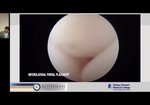
Video Player is loading.
Current Time 0:00
/
Duration 0:00
Loaded: 0%
0:00
Stream Type LIVE
1x
- 0.5x
- 0.75x
- 1x, selected
- 1.25x
- 1.5x
- 1.75x
- 2x
- Chapters
- descriptions off, selected
- captions settings, opens captions settings dialog
- captions off, selected
This is a modal window.
Beginning of dialog window. Escape will cancel and close the window.
End of dialog window.
10 seconds
Playback speed
This is a modal window. This modal can be closed by pressing the Escape key or activating the close button.
1,564 views
April 6, 2021
Dr. Peter J. Millett is an orthopedic shoulder surgeon with the Steadman Clinic in Vail, ...
read more ↘ CO and is the pioneer of the CAM procedure. The surgical technique of the CAM-procedure is explained in this short video.
Osteoarthritis is the most frequent cause of disability in the United States. It manifests itself as a gradual and progressive degeneration of the shoulder joint. This diseases is very debilitating and is classically characterized by pain, weakness, restricted motion, cartilage loss (which covers the joint surface of the upper arm bone and shoulder cavity), and can be associated with bony deformities called osteophytes.
Treatment of shoulder osteoarthritis should be based on the patient's age, severity of symptoms, level of activity, radiographic findings and other medical conditions present. Nonoperative treatment does not eliminate the actual pain cause but helps decreasing the symptoms. If this type of treatment fails, surgical treatment is a possible next step.
The most common surgical treatment for shoulder osteoarthritis is a total joint arthroplasty (replacement of the joint with a prosthesis), which offers satisfactory reports on pain reduction and functional outcome. This treatment method works well in older patients. Due to various reasons, such as the lifetime of the prosthesis, young, highly active patients are often poor candidates for shoulder arthroplasty.
The ideal surgical treatment for young active patients with symptomatic glenohumeral osteoarthritis is controversial. Dr. Millett has developed an aggressive arthroscopic (surgery through key holes) approach called Comprehensive Arthroscopic Management (CAM) for patients with advanced osteoarthritis as an alternative to arthroplasty.
↖ read less
read more ↘ CO and is the pioneer of the CAM procedure. The surgical technique of the CAM-procedure is explained in this short video.
Osteoarthritis is the most frequent cause of disability in the United States. It manifests itself as a gradual and progressive degeneration of the shoulder joint. This diseases is very debilitating and is classically characterized by pain, weakness, restricted motion, cartilage loss (which covers the joint surface of the upper arm bone and shoulder cavity), and can be associated with bony deformities called osteophytes.
Treatment of shoulder osteoarthritis should be based on the patient's age, severity of symptoms, level of activity, radiographic findings and other medical conditions present. Nonoperative treatment does not eliminate the actual pain cause but helps decreasing the symptoms. If this type of treatment fails, surgical treatment is a possible next step.
The most common surgical treatment for shoulder osteoarthritis is a total joint arthroplasty (replacement of the joint with a prosthesis), which offers satisfactory reports on pain reduction and functional outcome. This treatment method works well in older patients. Due to various reasons, such as the lifetime of the prosthesis, young, highly active patients are often poor candidates for shoulder arthroplasty.
The ideal surgical treatment for young active patients with symptomatic glenohumeral osteoarthritis is controversial. Dr. Millett has developed an aggressive arthroscopic (surgery through key holes) approach called Comprehensive Arthroscopic Management (CAM) for patients with advanced osteoarthritis as an alternative to arthroplasty.
↖ read less
Comments 0
Login to view comments.
Click here to Login





















